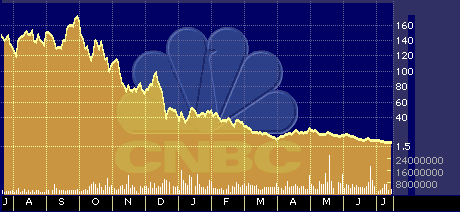
Venture Investments Up, But Returns Trend Downward
Venture Investments Up, But Returns Trend Downward
By Hal Plotkin
Silicon Valley Correspondent
Aug 2 1999 6:08AM ET
Venture capital investments in early-stage companies were up sharply during the second quarter this year despite a big drop recently in the average return that VCs had received on their investments.
“There is simply no way we could have maintained the pace of the last few years,” says Jim Breyer, managing partner at Palo Alto-based Accel Partners, which has over $1.3 billion under management. “We’ve told our partners that the returns we’re generating are unsustainable,” he says.
Accel has backed numerous high-flying start-ups, including RedBack Networks {RBAK}, NorthPoint Communications {NPNT}, and Portal Software {PRSF}, all of which completed their initial public offerings in recent months.

RedBack’s Year-to-Date Stock Performance
The average annual rate of return for venture capital firms investing in early-stage companies over the past three years was 43.4 percent, as compared with a still-healthy but more modest 18.1 percent during the last year.
Anyone expecting the occasionally triple-digit returns that some venture capital firms have posted in recent years “is simply self-delusional,” says Breyer.
| Funding Type | 1Yr. | 3 Yr | 5YR | 10YR | 20YR |
| Early/Seed – Focused | 18.6 | 43.4 | 31.4 | 19.0 | 16.6 |
| Balance – Focused | 5.3 | 28.5 | 24.5 | 15.4 | 14.0 |
| Later Stage – Focused | 9.4 | 25.3 | 28.1 | 21.6 | 17.2 |
| All Venture | 9.6 | 32.2 | 26.7 | 16.8 | 14.9 |
| Buyout Funds | 16.4 | 18.1 | 19.1 | 17.0 | 19.9 |
| Mezzanine – Debt | 5.1 | 9.7 | 11.1 | 10.0 | 10.5 |
| All Private Equity | 14.3 | 22.4 | 21.7 | 16.9 | 17.2 |
Source: National Venture Capital Association 1999 Yearbook
Breyer emphasizes, however, that venture capital rates of return are merely reverting to more historical patterns. Nonetheless, new money continues to pour into the coffers of the venture capital industry at a record-setting pace.
According to figures released by the National Venture Capital Association (NVCA), new venture capital investments swelled to $7.56 billion dollars in the second quarter of 1999.
In contrast, venture capital investments totaled roughly $6 billion for all of 1995.
“There has been a quite a substantial increase in new investments,” confirms John Taylor, NVCA’s director of research. “It means investors have confidence in the opportunities being created by the New Economy,” he says.
According to the NVCA, 958 companies received an average of $7.89 million dollars each from venture capital firms during the second quarter of this year. The average investment received by each company also went up during the second quarter, almost double what it was for the same quarter last year.
| Time Period | # of Companies | Ave.Investment Per Company | Total Venture Capital Investments |
| 1999Q2 | 958 | $7.89 million | $7.56 billion |
| 1999Q1 | 805 | $6.30 million | $5.06 billion |
| 1998Q4 | 944 | $5.41 million | $5.10 billion |
| 1998Q3 | 905 | $4.65 million | $4.20 billion |
| 1998Q2 | 859 | $4.96 million | $4.25 billion |
| 1998Q1 | 810 | $3.77 million | $3.05 billion |
Source: National Venture Capital Association
The primary reason for the increased size of average venture capital investments, according to Taylor, is that venture capital firms are putting more money into second and third rounds of financing.
“Companies getting first-round financing make up about half of the companies that received funds,” says Taylor of the NVCA. “But, taken together, they received only about one-third of the total dollars.”
Some observers worry the larger amounts going into second and third rounds of financing may mean at least some venture capital firms could be trying to bail out slow-to-perform assets by throwing more money at them.
“That’s really not the case,” says Taylor. “Typically, very early stage companies need less money.” The relatively more mature new companies that qualify for second and third rounds of venture financing often have more substantial needs tied to the execution of their business plans, he says.
Even so, larger average investments increase risk for venture capital firms.
As a rule of thumb, according to Taylor, history shows that about one-third of all venture capital-backed companies eventually fail. The question venture capital firms now face is whether larger returns from companies that succeed will balance out the larger losses that will almost certainly occur.
“I’m optimistic,” says Dick Kramlich, managing general partner at New Enterprise Associates (NEA), based in Baltimore. NEA was an early investor in companies such as Adaptec, Inc., Ascend Communications, Inc., and 3Com Corporation. Over 60 NEA companies have gone public since 1991.


